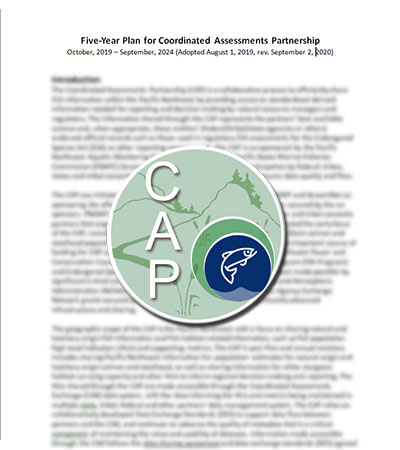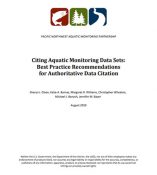The Five-Year Plan for the Coordinated Assessments Partnership (CAP) was updated and adopted by the StreamNet Executive Committee on August 1, 2019. This is the second five-year plan for CAP. In June, 2019 the StreamNet Executive Committee discussed this plan as an outline for CAP going forward for the next five years. The overarching goals of the 5-year workplan are:
- Maintain, update, and automate existing data flow.
- Continue to work with tribes via coordination with the tribal Inter-Tribal Monitoring Data (ITMD) Project.
- Maintain contact with NOAA, BPA and NPCC Fish & Wildlife Program Sponsors on data priorities and data management issues they wish to address.
- Maintain and refine existing DESs.
- Facilitate problem-solving with partner agencies (and others) on an ongoing basis.
- Discuss any potential new indicators with the StreamNet Executive Committee prior to initiating flow of data, such as new indicators to track towards targets that might benefit from regionally standardized data, and any data category focused on new efforts for regional data standardization under CAP.
- Involve the right people to address any new efforts that clearly fill a defined need and are prioritized for standardization, identifying experts to inform the development of the indicator(s) and DES.
- Finalize DESs for new indicators (if any) adopted the previous year and populate new indicators with data.
The plan is revisited annually to ensure alignment with regional priorities and changed as needed if regional priorities change. You can view the updated 2020 version of the Five-Year Plan for the Coordinated Assessments Partnership here.
Entities represented on the StreamNet Executive Committee are Bonneville Power Administration (BPA), Columbia River Intertribal Fish Commission (CRITFC), the Confederated Tribes of the Colville Reservation (Colville Tribes), Idaho Department of Fish and Game (IDFG), Montana Fish, Wildlife & Parks (MFWP), National Oceanic and Atmospheric Administration, National Marine Fisheries Service (NOAA), Northwest Power and Conservation Council (NPCC), Oregon Department of Fish and Wildlife (ODFW), Pacific Northwest Aquatic Monitoring Partnership (PNAMP), Pacific States Marine Fisheries Commission (PSMFC), U.S. Fish and Wildlife Service (USFWS), and Washington Department of Fish and Wildlife (WDFW).


